The Ultimate 6 Week 10K Running Training Plan + 7 Expert Tips
Author:
Reviewed by:
(Head of Sport Science, 20 years of Oly Lifting experience, PhD Sport Science)
Unlock your full potential by engaging with our experts and community! Have questions about your fitness journey or looking for expert advice on weightlifting techniques? Don’t hesitate — leave a comment below and Oleksandr Zagrebelnyi will provide a personalized answer and insights to help you reach your goals.
Torokhtiy is reader-supported. Some links are affiliate links, and we may earn a commission at no extra cost to you. See our disclosure page for details.
Are you looking for a 6 week 10k training plan to become a more experienced runner? With the right training plan, most runners can prepare for their first 10K in 6 weeks or less. This ultimate 10k training plan 6 weeks is an effective program designed specifically to help you reach peak performance.
How To Prepare For The 10K Distance? — Training for a 10k should include running three to four times per week, rest days for proper recovery, and other cross-training activities, such as core strengthening drills and dynamic stretching.
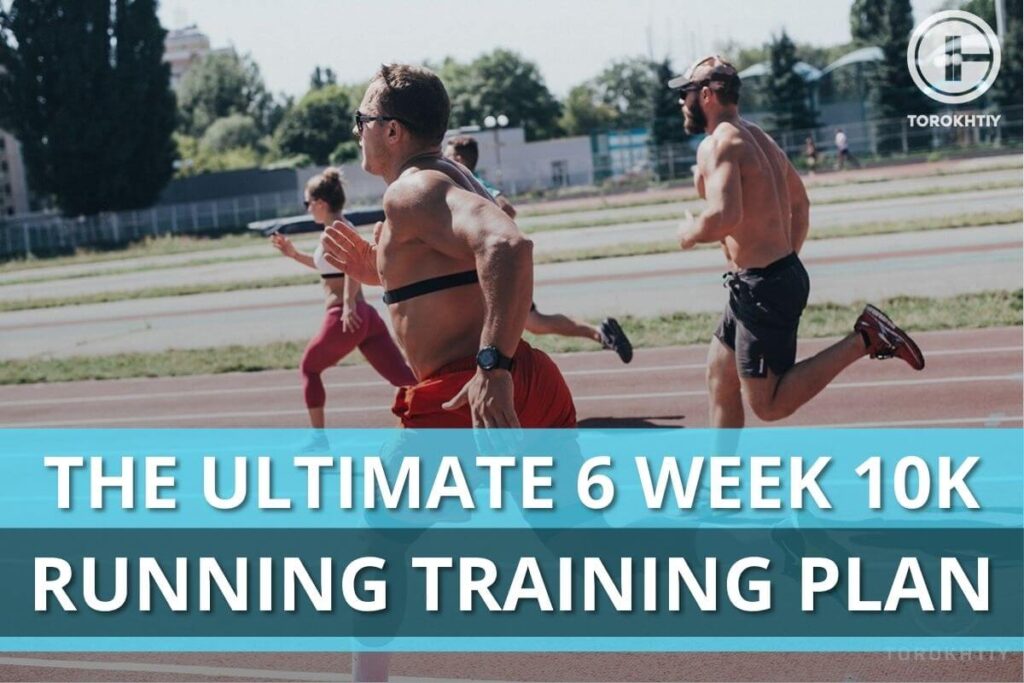
How Far Is A 10K For A Runner?
A 10K is 6.2 miles long and takes about 9,100-11,200 steps. It is a popular distance for both novice and experienced runners.
Longer than any sprint event but shorter than a half marathon, the 10K distance serves as a nice challenge for anyone who wants to push themselves without having to commit too much time or effort.
Runners of all levels (beginners, recreational athletes, and even experienced marathoners) enjoy this distance due to the fact that it is manageable but still rewarding. Those new to running can use it as a stepping stone to longer-distance events.
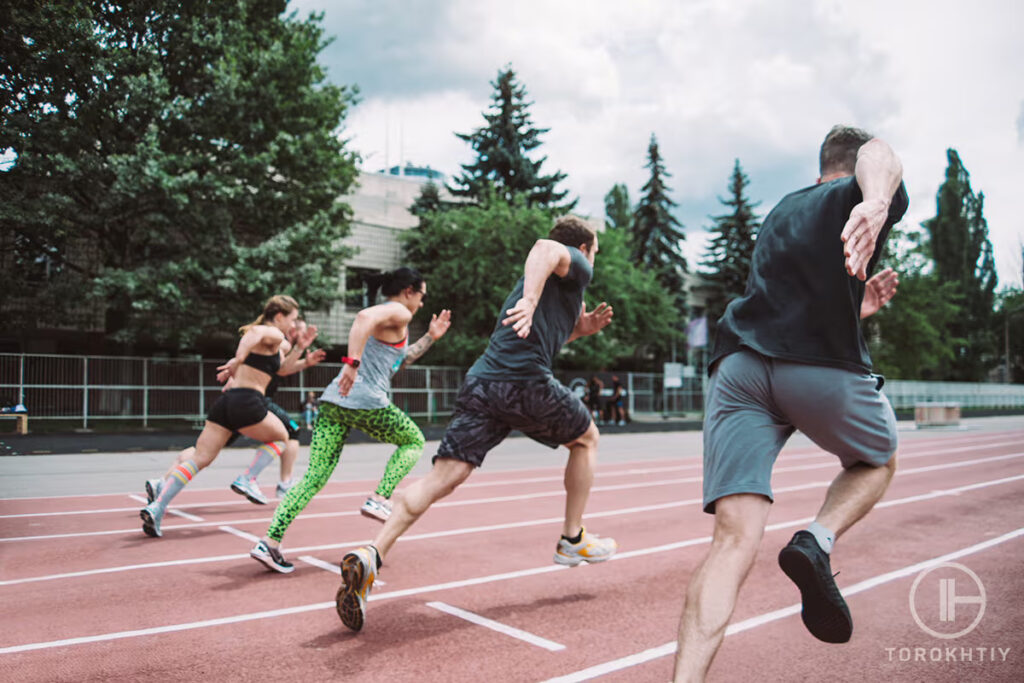
Average Running Time For 10k
The average running pace for a 10K race depends on many factors, including age, gender, and level of fitness. Generally speaking, adult males tend to have an average running pace of 9:07 minutes per mile in a 10K race, which equates to 5:51 per kilometer.
Adult females average around 10:21 minutes per mile, or around 6:00 per kilometer. Beginners can expect to run at 11:00-12:45 min/mile, whereas recreational runners with moderate training will have an improved pace that ranges from 8:00-9:00 min/mile.
Finally, experienced competitive athletes may reach paces around or under 7:00 min/mile, with elite athletes running even faster.
Here’s a table showing an average 10k time:
| Experience | Male | Female |
|---|---|---|
| Beginner | 01:05-01:15 | 01:15-01:25 |
| Mid-experience | 00:46:00:52 | 00:54-00:59 |
| Experienced | 00:40-00:44 | 00:44-00:46 |
Now let’s discuss how long to train for a 10k.
Is Training For A 10K In 6 Weeks Realistic?
Training for a 10k race in 6 weeks is achievable, depending on the current fitness level of the runner and their previous running experience. Even beginner runners may find it possible to finish a 10k in 6 weeks by slowly increasing mileage and focusing on good mechanics during each session.
6-Week 10k Training Plan – Beginner
Kickstart your 10k journey with this week-by-week beginner plan to help you gain endurance and strength in just 6 weeks!
Pro Tip
Start each run with a light 5- to 10-minute warmup routine that includes dynamic stretching. Activities such as jogging in place, arm circles, leg kicks, and calf raises can help warm up your body for the workout ahead.
Running Coach Nike Run Club Kyiv
It might seem like running three to four times a week isn’t enough, but rest days are an important part of any successful training plan. Several runs each week with adequate rest will help prevent injury and build the base needed for success on race day.
| Week | Monday | Tuesday | Wednesday | Thursday | Friday | Saturday | Sunday |
|---|---|---|---|---|---|---|---|
| 1 | 2 miles easy pace | Rest day | Cross-training | 2.5 miles easy pace | 30-min recovery jogging | 3 miles long run | Rest day |
| 2 | 3 miles easy pace | Speed work | Cross-training | Speed work | 40-min recovery jogging | 4 miles long run | Rest day |
| 3 | 3 miles easy pace | Speed work | Cross-training | 3 miles easy pace | 40-min recovery jogging | 4 miles long run | Rest day |
| 4 | 4 miles easy pace | Core and leg strength training | Rest day | Speed work | 40-min recovery jogging | 5 miles long run | Rest day |
| 5 | 4 miles easy pace | Core and leg strength training | Rest day | Drills | 40-min recovery jogging | 6 miles long run | Rest day |
| 6 | 5 miles easy pace | Core and leg strength training | Rest day | Drills | Rest day | Rest day | Rest day |
Week 1
This week is meant to be more of a “getting to know your body” phase rather than intense training. Beginners should start off slowly and focus on gradually gaining stamina and speed.
During this first week, aim to keep all runs easy and relaxed, running at a conversational pace.
Week 2
Week two involves adding distance and intensity, with a focus on speed. Two easy runs will give runners time to stretch their legs out. One should be at least 4 miles long, while the shorter run should end at around 3 miles.
On the speed work day, try intervals of half a mile or 800m repetitions, with max speed during intervals and recovery jogs in between.
Week 3
Week 3 of this 6-week 10k training program for beginners is designed to help runners prepare their bodies and minds for the upcoming race. It consists of two easy runs, one day of speed work, one long run, and a recovery run, with one rest day.
Week 4
During week 4, runners should focus on gradually increasing distance, using the same basic schedule as during the previous week. The only difference is adding strength training to enhance leg and core muscles.
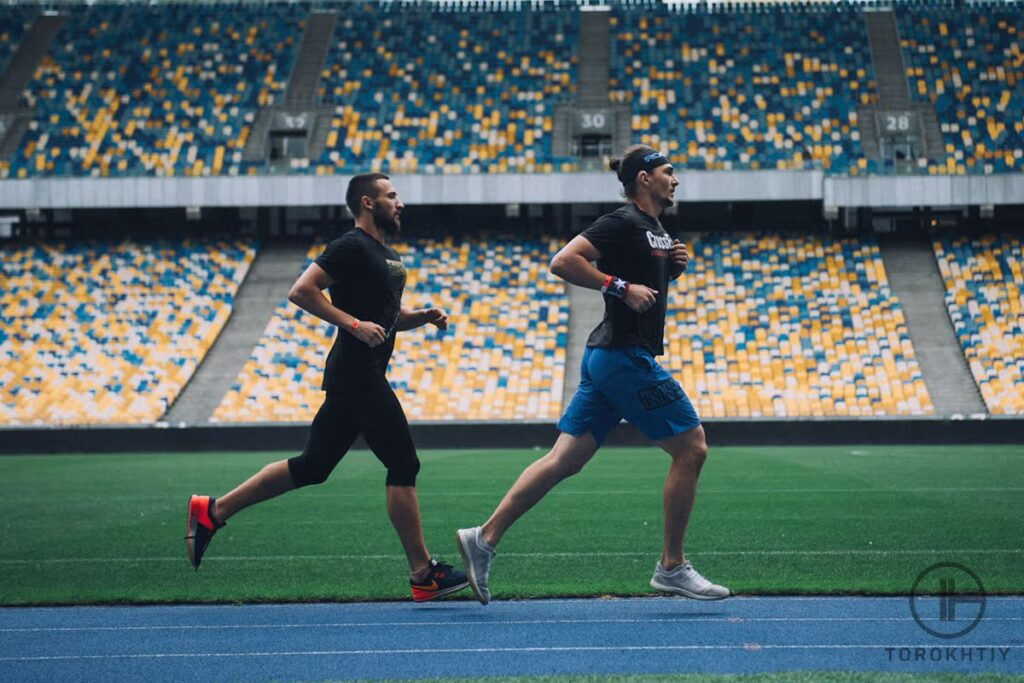
Week 5
Week 5 is designed to give runners the chance to push and challenge themselves as they begin running faster over longer distances. During this week, make sure to start incorporating track workouts into your routine.
This will involve a combination of speed work and drills on the track, one or two days during the week. Shorter sprints (such as 200-meter repeats) along with slow jogs can help build up endurance and allow you to practice pacing yourself correctly.
Week 6
The final part of training for a 10k in 6 weeks is all about preparation for race day. This is your last chance to increase your endurance, with a few runs tailored specifically to success on race morning.
Your body needs time to taper and rest in order to recover from 6 weeks of hard workouts. That way, you can complete your first 10k feeling strong. Start each run during this period at an easy pace, and then gradually build up speed.
6-Week 10k Training Plan – Intermediate Runners
This plan is tailored to those who have some running experience and are ready to take their 10k training up a notch. It lays out detailed workouts for each of the 6 weeks.
| Week | Monday | Tuesday | Wednesday | Thursday | Friday | Saturday | Sunday |
|---|---|---|---|---|---|---|---|
| 1 | 4 miles easy pace | Core and leg strength training | 4 miles easy pace | Speed work | 40-min recovery run | 5 miles long run | Rest day |
| 2 | 4 miles easy pace | Hill intervals | 4 miles easy pace | Speed work | 40-min recovery run | 5 miles long run | Rest day |
| 3 | 5 miles moderate pace | Core and leg strength training | 4 miles moderate pace | Speed work | 50-min recovery run | 6 miles long run | Rest day |
| 4 | 5 miles moderate pace | Cross-training and stretching | 4 miles moderate pace | Speed work | 50-min recovery run | 6 miles long run | Rest day |
| 5 | Hill reps | Cross-training and stretching | Speed work | Core and leg strength training | 5 miles moderate pace | 7 miles long run | Rest day |
| 6 | Hill reps | Rest day | 5 miles moderate pace | 50-min recovery run | Rest day | Rece day | Rest day |
Week 1
This week’s plan consists of five days of running, including two easy runs, one day devoted to speed work to help increase leg strength, one long run that builds endurance and improves stamina, and one recovery run at a low intensity.
Week 2
The second week should include six days of running, with two easy runs, two speed work sessions, one long run, and one recovery run. The goal of the speed work sessions is to help you develop better form and efficiency when it comes to your stride length, as well as increase your pace during races.
Week 3
Week 3 includes five runs: two easy runs at moderate intensity, one day of high-intensity speed work, one long run to build endurance gradually in time for race day, and a recovery run.
Week 4
This week has the same schedule as the previous week, aimed at increasing distance and including one day of cross-training and stretching/mobility exercises.
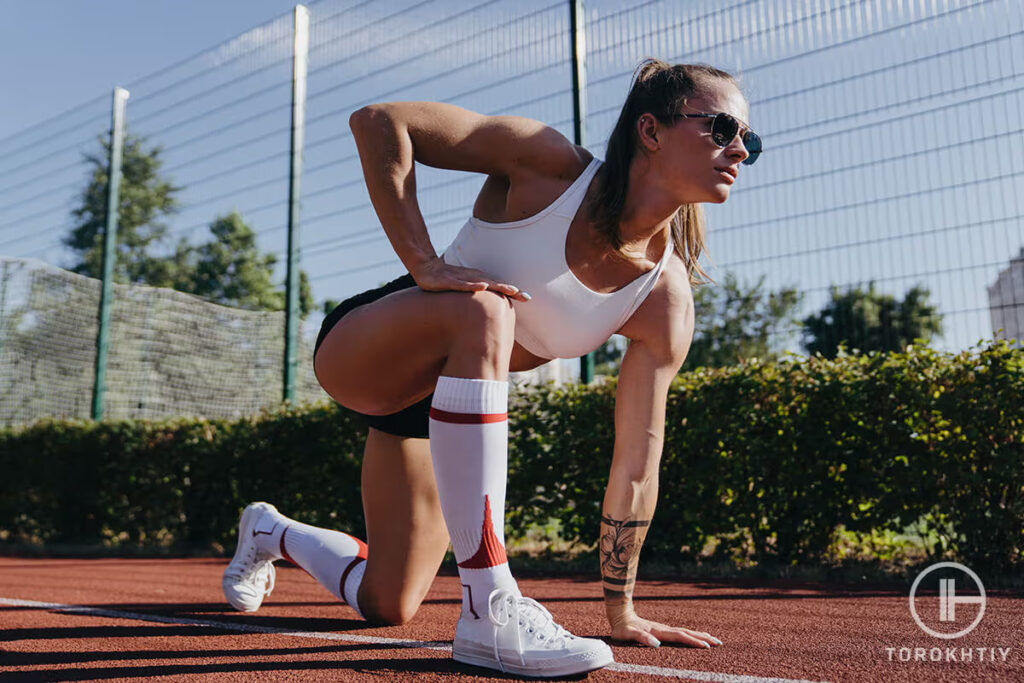
Week 5
The fifth week is focused on increasing your pace and maximizing your performance. During this week, you will be running four days, with each day dedicated to a different type of workout, such as hill runs, speed work, long run, and moderate pace run.
Week 6
This is the final week of your 10k training plan, and it’s time to get ready for race day! For this week, focus on tapering so that you can perform your best on the day of the race. This means reducing overall mileage and intensity, as well doing shorter runs throughout the week.
7 Tips For Following A 6 Week 10K Training Plan
Here are the seven best tips to improve your 10k results:
1. Consistency In Training
When training for a 10K race in only 6 weeks, it is vital to train consistently and build the strength and endurance that will be required to successfully finish the race.
For beginners looking to train for their first 10k, maintaining a consistent plan of three to four runs per week can help them make significant progress.
For intermediate-level runners aiming to improve their 10K time, it’s important to do dynamic training that incorporates variability into workouts.
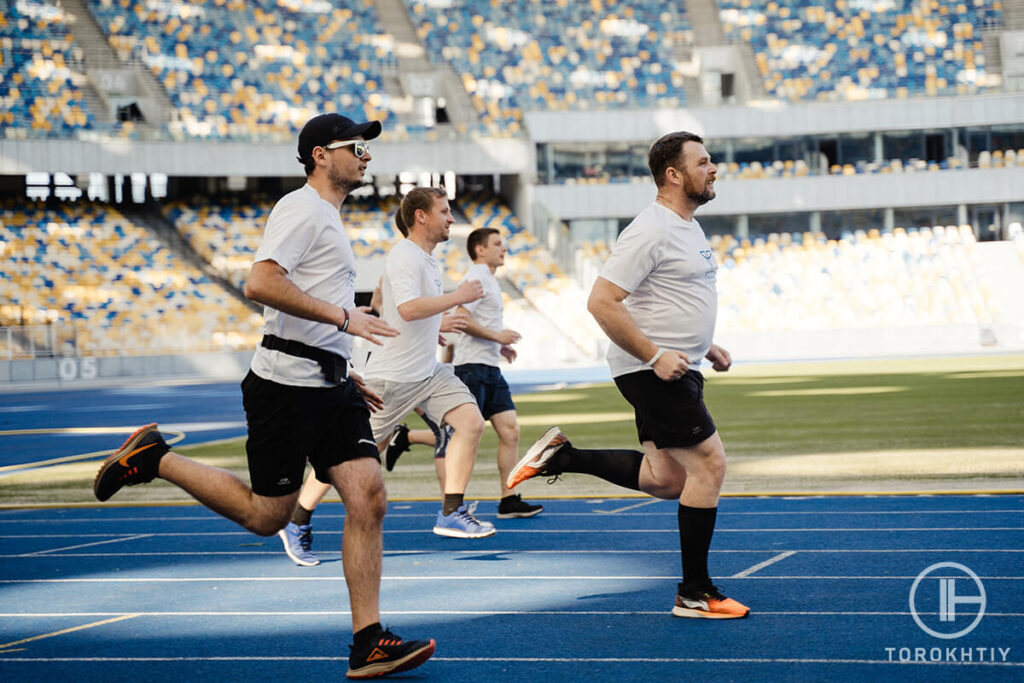
2. Incorporate Rest Days
Rest allows the body to repair and rebuild broken-down muscle tissues after intense training, reducing the risk of overtraining or burnout.
Moreover, rest maintains mental sharpness and keeps motivation high when your workout goals become challenging. To benefit from recovery, it is recommended that runners have one to two complete rest days per week. This means no running at all on these days.
3. Proper Nutrition For Fueling
Training for a 10K requires intense physical activity. Consuming a balance of carbohydrates and protein helps replenish energy stores while aiding in recovery after workouts.
Pro Tip
This balance should consist of at least 50-60 percent slow-burning carbohydrates, along with lean proteins. This will provide the caloric intake required to support each training session. Replenishing carbohydrates is a key, but don’t forget to include some healthy fats in your diet, as well.
Running Coach Nike Run Club Kyiv
4. Proper Clothing And Footwear
Good-quality running shoes that are properly fitted for cushioning, support, and stability are essential to prevent injuries like shin splints, plantar fasciitis, and knee pain.
Moisture-wicking and breathable clothes allow runners to stay dry during workouts while also providing them with freedom of movement. Moreover, the correct clothing helps ensure safety from weather changes and enables maximal efficiency on race day.
Hoka Bondi 8
- Material: Breathable and supportive mesh upper
- Sole Material: Full-length EVA midsole for maximum cushioning
- Outsole (tread feature): Durable rubber outsole with a unique lug pattern
- Drop: 4mm
- Season: Suitable for all seasons
- Special Features: Exceptional cushioning and comfort
- Size: Available in various sizes
- Type: Maximum cushioning running shoe
If you want excellent running or walking shoes or just footwear you’ll be comfortable in, you can’t go wrong with the Hoka Bondi 8.
It’s been upgraded and now they have lighter, softer materials and a new extended heel design. The heel design gives a super soft, balanced feeling from th emoment your heel hits the ground to when you push off with your toes.
As far as the weight goes, it’s around 10.80 ounces, and the heel drop is 4 mm. They’re not too heavy and the lower drop is a good balance between cushioning and feeling connected to the ground.
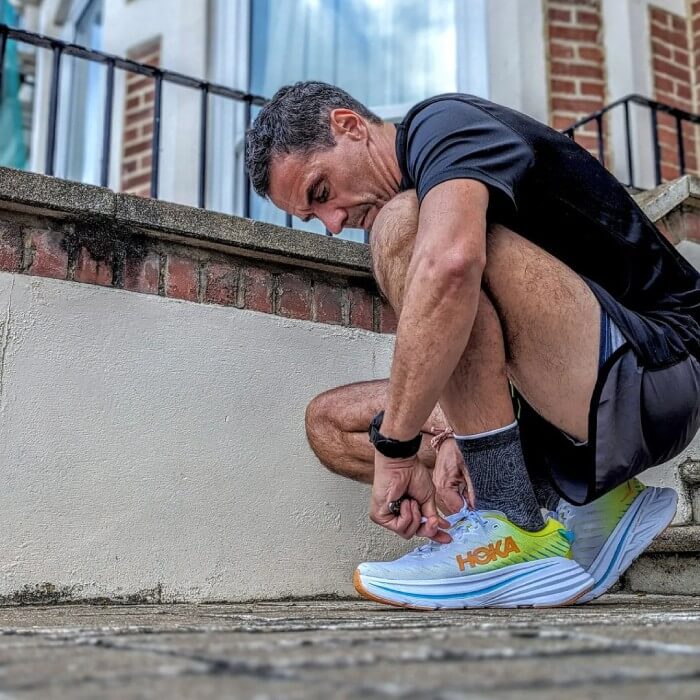
The Bondi 8 is focused on cushioning and keeps things simple. There’s a good amount of support without any extra stuff that you don’t really need and that would only jack up the price. Take the rear crash pad, for example – it makes for a soft, smooth ride, which is perfect if you like to run outdoors.
The upper part is made of engineered mesh, which is breathable and keeps your feet cool and dry. The tongue and collar have memory foam and mold to your foot shape. All of these features make the fit snug but flexible, which is exactly what you would want.
The Bondi 8 is eco-friendly because it uses recyclable materials in parts like the mesh and the sockliner. Plus, the shoes are completely vegan, which (if that’s important to you) is nice!
5. Cross-Training Activities
Incorporating cross-training activities into workouts can help reduce the stress of running alone, while also building aerobic endurance. Regularly performing exercises other than running helps manage the risk of injury.
Pro Tip
For beginner runners transitioning from 5k to 10k distances, an easy way to transition is by swapping in different forms of low-impact cardio like biking or rowing between running days to gradually build speed and stamina.
Running Coach Nike Run Club Kyiv
6. Stretching And Mobility Exercises
Stretching can help runners improve performance by increasing flexibility, range of motion, circulation, and balance.
Mobility exercises aid in injury prevention, as they activate your muscles and improve your coordination. These exercises also promote the recovery process, reducing muscle stress and helping prevent further pain or damage.
7. Monitor Progress And Adjust The Training Plan
We can’t overstate the importance of tracking progress during a 6-week 10k training plan. As you begin to push yourself more, it is wise to use performance metrics to adjust your pace as needed.
Pro Tip
If your pace declines or if you get injured along the way, make sure that adjusting your timeline for finishing is part of your strategy. While ambitious time goals are an important factor in motivation, it’s essential to monitor both physical and mental fatigue, as well.
Running Coach Nike Run Club Kyiv
FAQ
How Much Water Should I Drink During A 10K Race?
You need to drink around 3-5 oz on the food point (at the 5k distance). Generally speaking, drinking small sips of water rather than big gulps is recommended in order to ensure that your body maintains optimal hydration levels.
How Can I Run A 10K Faster In 6 Weeks?
Improving 10K race times in 6 weeks requires a consistent training plan with the right combination of endurance and speed. Incorporating interval training, such as sprints or hill repetitions, is essential for improving speed over this short time period.
Conclusion
This 6-week training plan for 10k is an effective program for any runner looking to prepare themselves physically and mentally for a successful 10k race. It’s designed specifically with beginners and intermediate runners in mind to gradually build endurance over time, but it can easily be tailored to suit more advanced runners.
Each week of the 10k 6-week training plan offers progressive challenges that will help you maintain your focus and give you structure as you prepare for race day. By adhering closely to this 6-week training program, runners of all levels can expect improved performance and increased confidence in their abilities.
Have you already tried running a 10k? Please share your experience in the comments below.
Also read:
References:
- Overtraining Syndrome // PMC: https://www.ncbi.nlm.nih.gov/pmc/articles/PMC3435910/
- Dietary Intake of Recreational Endurance Runners Associated with Race Distance—Results from the NURMI Study (Step 2) // MDPI: https://www.mdpi.com/2072-6643/14/18/3698
- Highly Cushioned Shoes Improve Running Performance in Both the Absence and Presence of Muscle Damage // Medicine & Science in Sports & Exercise (MSSE): https://journals.lww.com/acsm-msse/Fulltext/2022/04000/Highly_Cushioned_Shoes_Improve_Running_Performance.10.aspx
- The Role of Sports Clothing in Thermoregulation, Comfort, and Performance During Exercise in the Heat: A Narrative Review // SpringerOpen: https://sportsmedicine-open.springeropen.com/articles/10.1186/s40798-022-00449-4
- Cross Training // OrthoInfo: https://orthoinfo.aaos.org/en/staying-healthy/cross-training/
- Photos are made by Torokhtiy Media Team
Why Trust Us?
With over 20 years in Olympic weightlifting, strength training, nutrition coaching, and general fitness our team does its best to provide the audience with ultimate support and meet the needs and requirements of advanced athletes and professional lifters, as well as people who strive to open new opportunities and develop their physical capabilities with us.
By trusting the recommendations of our certified experts in coaching, nutrition, and sports training programming, as well as scientific consultants, and physiotherapists, we provide you with thorough, well-considered, and scientifically proven content. All the information given in the articles concerning workout programming, separate exercises, and athletic performance, in general, is based on verified data.
The product testing process is described in more detail here.
Oleksandr is a running coach and member of the Nike Run Club coaching team for 8 years. A participant in national and international competitions at distances from one kilometer to the ultra trail. Owner of mountain trail running camps. Nowadays Oleksandr is responsible for creating running training programs for athletes of various levels, coaching personally offline and online, conducts trail running camps in the mountains, participates in competitions.
Reviewed by: Sergii Putsov
Head of Sport Science, PhD
Best Results: Snatch – 165 kg,
C&J – 200 kg
Sergii Putsov, Ph.D., is a former professional weightlifter and National team member, achieving multiple medals in the 94 kg weight category at national competitions. With a Master’s degree in “Olympic & Professional Sport Training” and a Sport Science Ph.D. from the International Olympic Academy, Greece, Sergii now leads as the Head of Sport Science. He specializes in designing training programs, writing insightful blog articles, providing live commentary at international weightlifting events, and conducting educational seminars worldwide alongside Olympic weightlifting expert Oleksiy Torokhtiy.





Still have questions after reading our article? Unlock your full potential by engaging with our experts and community! Don’t hesitate — leave a comment below and Oleksandr Zagrebelnyi will provide a personalized answer and insights to help you reach your goals.